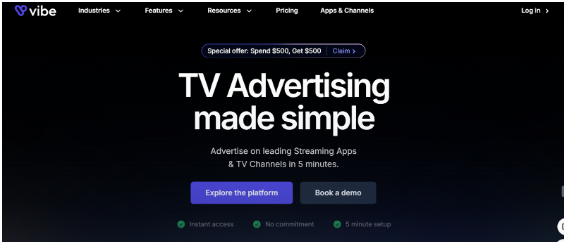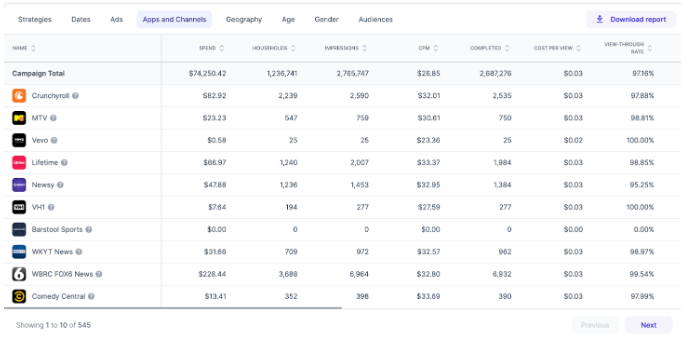Linear TV Advertising Explained: 15 Key Insights on Performance and Audience Metrics
Do you ever wonder why traditional TV advertising is still relevant in a world dominated by streaming services?
I used to think linear TV was fading fast—until I took a closer look.
Despite the rise of digital platforms, linear TV remains a powerhouse, especially for live events, older demographics, and premium brand positioning.
It continues to offer unmatched reach and engagement. I realized how brands are adapting, using both traditional TV and modern strategies to maximize their impact.
In this guide, you’ll discover:
- How linear TV advertising works in today’s market
- Its key advantages and challenges
- The performance metrics that truly matter
- How platforms like Vibe.co can enhance your TV ad strategy
By the end, you’ll have a clear understanding of how to make linear TV work for your brand—whether you're a traditional advertiser or looking to blend it with digital strategies.
What Is Linear TV Advertising?
Linear TV refers to traditional scheduled programming where ads are bought in advance and aired at fixed times.
Unlike streaming (Connected TV), where viewers can watch content on demand, linear TV follows a set broadcast schedule.
Despite shifting viewing habits, linear TV still holds strong, particularly for live events like sports, award shows, and primetime news—where millions tune in simultaneously. This makes it a powerful channel for advertisers looking to reach broad audiences.
How Does Linear TV Advertising Work?
- Advertisers purchase ad slots from TV networks or cable providers.
- Ads are scheduled within specific programs based on the target audience.
- Viewers watch non-skippable ads, ensuring high visibility and brand exposure.
- Performance is measured using key metrics like reach, impressions, and TV ratings.
Pros and Cons of Linear TV Advertising
Advantages of Linear TV Advertising
- Massive reach – Major networks still attract millions of engaged viewers.
- Brand credibility – Traditional TV advertising is perceived as a premium and trustworthy marketing channel.
- Non-skippable ads – Unlike YouTube or streaming platforms, TV ads play in full, ensuring complete brand messaging.
- High engagement for live events – Sporting events, award shows, and political debates drive appointment viewing, making ads more impactful.
Disadvantages of Linear TV Advertising
- Declining younger audiences – Many younger viewers have migrated to digital and streaming platforms.
- High costs – Prime-time TV ad slots can be expensive, limiting access for smaller brands.
- Limited targeting – Ads rely on broad demographic data rather than hyper-personalized segmentation.
- Lack of performance data – When compared to digital ads, measuring ROI is more challenging.
Linear TV remains a valuable advertising tool, but brands must weigh its strengths and limitations when planning their marketing strategies.
15 Key Insights on Performance and Audience Metrics for Linear TV Advertising
These insights help advertisers measure impact, optimize performance, and maximize return on investment.
Let’s break down the essential performance and audience metrics that matter in linear TV advertising.
1. Reach & Impressions
Reach or Impressions are the total number of unique viewers who see an ad.
Why it matters:
- A higher reach means more brand awareness.
- Impressions indicate how many times an ad was displayed, giving insight into its visibility.
How to optimize it:
- You can buy ad slots during high-viewership programs.
- Also, can place ads in prime-time slots for maximum exposure.
2. Gross Rating Points (GRP)
GRP is a measure of an ad campaign’s impact based on the percentage of the target audience reached and the frequency of exposure.
Why it matters:
- It helps advertisers gauge overall campaign effectiveness.
- Higher GRPs indicate wider audience penetration.
How to optimize it:
- It can increase ad frequency in key time slots.
- You must choose high-impact TV shows with strong audience engagement.
3. Target Rating Points (TRP)
TRPs are a refined version of GRP that focuses on a specific audience segment rather than the general TV audience.
Why it matters:
- Allows for better targeting of ideal customers.
- Ensures ad spend is focused on relevant demographics.
How to optimize it:
- Use audience insights to select programs that align with your ideal customer profile.
- Adjust frequency based on engagement levels within your target market.
4. Cost Per Thousand (CPM)
CPM is the cost of reaching 1,000 viewers with a TV ad.
Why it matters:
- Helps advertisers compare the efficiency of different ad placements.
- Lower CPM means better cost efficiency.
How to optimize it:
- You can choose TV networks that offer high engagement at lower costs.
- Also, negotiate better rates with networks based on historical performance data.
5. Ad Frequency
The Ad Frequency is the number of times an audience sees an ad during a campaign.
Why it matters:
- Too low, and viewers may forget your message.
- Too high, and it can lead to ad fatigue.
How to optimize it:
- You need to find the sweet spot—typically between 3 to 10 exposures per viewer.
- Make sure to rotate multiple versions of an ad to keep content fresh.
6. Return on Ad Spend (ROAS)
ROAS is the revenue generated per dollar spent on TV advertising.
Why it matters:
- It helps measure profitability and justify ad spend.
- A high ROAS indicates a well-optimized campaign.
How to optimize it:
- Try to track conversions from TV ads using QR codes or website visits.
- You can pair TV campaigns with digital retargeting for better attribution.
7. Prime Time vs. Off-Peak Performance
It’s basically comparing ad performance in high-traffic vs. lower-traffic TV slots.
Why it matters:
- Prime-time ads cost more but deliver higher engagement.
- Off-peak ads may offer cost-effective reach.
How to optimize it:
- You can mix prime-time and off-peak slots to balance cost and exposure.
- Try to analyze previous campaign performance to determine the best schedule.
8. Audience Demographics
Audience demographics are important for understanding the age, gender, and interests of viewers.
Why it matters:
- It ensures ads are reaching the right customer segments.
- Older demographics remain highly engaged with linear TV.
How to optimize it:
- You can use data from past campaigns to refine audience targeting.
- Always choose programs that align with your brand’s ideal customer profile.
9. Ad Recall Rates
Ad Recall rates are important to know how well viewers remember a brand or message after seeing an ad.
Why it matters:
- Strong ad recall leads to higher brand awareness and engagement.
- TV ads typically have better recall rates than digital ads.
How to optimize it:
- You can use memorable visuals and clear messaging.
- Reinforce brand elements (logo, tagline, colors) throughout the ad.
10. Engagement Metrics
It measures how actively viewers interact with an ad's message.
Why it matters:
- Ads aired during live sports or reality shows tend to generate more interest.
- Highly engaging ads result in better audience retention.
How to optimize it:
- You can align ad placement with high-involvement programming.
- Also, include compelling storytelling to enhance viewer connection.
11. Household Viewing Habits
It is basically how families and co-viewers consume TV content together.
Why it matters:
- Co-viewing increases ad exposure across multiple demographics.
- Family-oriented ads may perform better in specific time slots.
How to optimize it:
- You should run ads during family-friendly shows or weekend time slots.
- Try to leverage insights on shared viewing habits for better targeting.
12. Ad Placement Impact
It's the position of an ad within a commercial break.
Why it matters:
- First and last ads in a break tend to have the highest retention.
- Mid-break ads may suffer from lower engagement.
How to optimize it:
- Try to invest in premium placements (first or last in the break).
- Make sure to test different positions to find the best-performing slot.
13. Competitive Ad Clutter
It's the number of competing ads within the same commercial break.
Why it matters:
- A crowded break reduces individual ad effectiveness.
- Too many ads in a row can lead to viewer disengagement.
How to optimize it:
- Always choose less saturated time slots for better visibility.
- Try to space out campaign placements to avoid being lost in the mix.
14. Cross-Channel Synergy
Cross-Channel Synergy is the impact of combining linear TV with streaming or Connected TV (CTV).
Why it matters:
- A blended approach improves overall brand reach.
- Viewers exposed to TV and digital ads are more likely to convert.
How to optimize it:
- You can use platforms like Vibe.co to integrate linear TV with CTV for a seamless ad strategy.
- Make sure you track cross-channel performance to refine audience targeting.
15. Conversion Tracking Challenges
It is the difficulty of directly measuring TV ad-driven conversions.
Why it matters:
- Unlike digital ads, TV lacks real-time click-through tracking.
- Attribution remains a challenge without supporting data.
How to optimize it:
- You can use QR codes or vanity URLs in TV ads to track response rates.
- Try to pair TV ads with digital retargeting to measure post-ad engagement.
Now that we know almost everything about Linear TV, let’s see how television advertising has evolved.
Brands now have two major options: Linear TV and Connected TV (CTV). While both serve distinct purposes, the shift toward digital-driven advertising is undeniable.
Linear TV vs. Connected TV Advertising
Linear TV: Traditional, Yet Powerful
- It delivers scheduled programming with ads pre-bought and aired at fixed times.
- It is ideal for reaching mass audiences during live events, like sports and primetime news.
- It offers brand credibility but lacks precise targeting and detailed performance tracking.
Connected TV (CTV): The Future of TV Advertising
- It delivers ads via streaming services on smart TVs, Roku, Firestick, Apple TV, and more.
- It allows precise audience targeting, meaning brands can reach viewers based on demographics, behavior, and interests.
- This provides data-driven insights with real-time performance tracking and retargeting capabilities.
- It supports dynamic ad placements, ensuring brands can optimize based on engagement metrics.
Also read: CTV, OTT and Linear TV, what is the difference?
Why Advertisers Are Shifting to CTV
While linear TV remains valuable for broad awareness, modern advertisers demand more control, flexibility, and measurability.
Connected TV delivers that, making TV advertising as data-driven and accessible as digital marketing.
How Vibe.co Transforms TV Advertising

Vibe.co is redefining TV advertising, making it as simple as running a Facebook or Google ad. With access to over 500+ streaming channels, brands can:

- You can launch campaigns in minutes with a user-friendly platform.
- It helps you target the right audience based on demographics, location, and interests.
- You can track performance in real time, ensuring maximum ad impact.
- It has a very affordable pricing structure starting from $50 per day.
Also read: 5 Best CTV Advertising Examples You Must Check
Conclusion
Linear TV advertising is still a powerful tool for mass reach and live event engagement, but modern advertisers need more than just broad exposure—they need precision, flexibility, and measurable results.
By shifting to Connected TV (CTV), brands gain the ability to target the right audience, track ad performance in real time, and optimize campaigns for maximum ROI.
The best part? Making this transition doesn’t have to be complicated.
You can start by testing a CTV campaign alongside your linear TV efforts.
With platforms like Vibe.co, launching a TV ad campaign is as simple as running a digital ad.
You can:
- Reach the right audience across 500+ streaming channels.
- Fine-tune your ad placements with real-time performance tracking.
- Maximize your ROI with precise targeting and dynamic ad delivery.
Get started with Vibe.co today to launch your first campaign!



